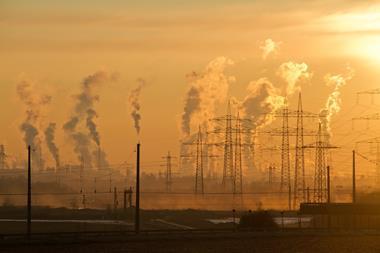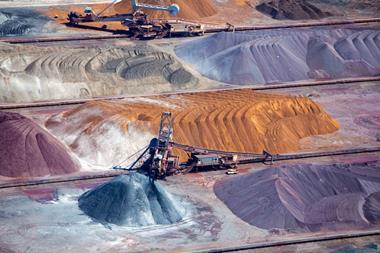For those following the debate around global climate change, a curious split is becoming apparent. On the one side – despite ever-firming scientific certainty about the impact of man-made greenhouse gas (GHG) emissions on global temperatures – political initiatives to tackle the problem seem in limbo.
The Kyoto Protocol, the international agreement that sets caps on industrialised world emissions from 2008, is currently held hostage by Russia, whose ratification is now required for its entry into force. And environmentalists complain that the Bush Administration – which withdrew the US from the Protocol in 2001 – is doing little domestically or abroad to attempt to slow climate change.
But on the other hand, there is growing concern within the investment community about the issue. Significant institutional investors are beginning to ask questions of the companies in which they invest about GHG emissions, and whether they are managing the financial risks that climate change poses.
In February, US investors claimed a major breakthrough when American Electric Power and Cinergy – two of the US’ largest power companies – agreed to report on how they are responding to growing pressure to reduce GHG emissions. Both faced shareholder resolutions on the issue, which have now been withdrawn.
These resolutions were, admittedly, tabled by the ‘usual suspects’ of the shareholder activist community – socially responsible and religious investors. But ‘mainstream’ investors in the US are also mobilising behind the issue. Last November, a conference in New York saw the launch of the Investor Network on Climate Risk (INCR), formed by state and city treasurers and comptrollers and two labour pension funds. The conference was attended by senior executives from Bank of America, Goldman Sachs, Lazard Asset Management, and Morgan Stanley, among others.
They issued a 10-point action plan, calling on the Securities and Exchange Commission, corporate boards and Wall Street firms to increase corporate disclosure of climate change risks.
At the time, California State Treasurer Phil Angelides, one of the INCR members, said: “In global warming, we are facing an enormous risk to the US economy and to retirement funds that Wall Street has so far chosen to ignore … As fiduciaries, we must take it upon ourselves to identify the emerging environmental challenges facing the companies in which we are shareholders, to demand more information, and to spur needed actions to respond to these challenges.”
In February, Angelides followed this with a four-pronged “environmental disclosure and investment initiative”. It calls on CalPERS and CalSTRS – two of America’s three largest public pension funds, and on whose boards Angelides sits – to, among other things, demand that the companies in which they invest disclose information on climate risks.
This mobilisation of US investors on the climate change issue follows on the heels of two European investment initiatives – the Carbon Disclosure Project (CDP), and the Institutional Investor’s Group on Climate Change (IIGCC).
The first, the Carbon Disclosure Project, was launched in 2000. In May 2002, 35 institutional investors managing assets then worth around $4.5trn (E3.6trn) wrote to the chairman of the world’s 500 largest companies, asking them to disclose “investment relevant information” concerning their greenhouse gas emissions.
Then, 245 completed the short questionnaire. It asked: whether the company concerned considers climate change to pose a risk, or opportunity, to its business; the quantity of GHG emissions it produces; whether it is measuring the emissions generated by the use and disposal of its products, and by its supply chain; whether it has emission reduction targets in place; and how it could reduce its emissions by 5%, 10% and 20%.
In May, the CDP is to report on its second questionnaire – sent to the same companies, but this time backed by 87 investors holding over $9trn in assets. Those companies that responded the first time around will be asked to report then on progress. Those that didn’t will be invited to do so.
The IIGCC, meanwhile, was formed it 2001 to promote better understanding of climate change among institutional investors, and to encourage companies to address any material risks and opportunities to their businesses associated with the climate change and a shift to a lower carbon economy.
What is striking about all these initiatives – apart from the size of assets controlled by their members – is the breadth of support for them across the investment world. 1, socially responsible investment providers – such as Jupiter Asset Management and Storebrand Investments in Europe, and Calvert and Domini Social Investments in the US – are prominent supporters.
But the list of CDP signatories, for example, includes names such as Gartmore Investment Management, Merrill Lynch Investment Management, and State Street Global Advisors.
The reason for their involvement is that, increasingly, investors are becoming aware of the business risks posed by climate change. In a report accompanying the results of the first CDP questionnaire, US-based investment research company Innovest Strategic Value Advisors spelt out how companies could be affected by climate change.
It notes that companies face two types of climate change-related financial risks. The first comes from the direct impacts of global warming. Evidence is emerging of changing weather patterns – with Europe facing drier summers and wetter winters, for example. Agriculture, energy production, tourism, and forestry are all likely to be affected.
Climate change is also leading to more extreme weather events. The insurance sector, in particular, is vulnerable to increased pay-outs from wind storms in Europe, hurricanes in North America, and flood damage.
Regulatory action to reduce GHG emissions poses a second set of financial risks. If the Kyoto Protocol enters into force, much of the responsibility for meeting emissions reduction targets will fall on the private sector.
Indeed, from next year, more than 15,000 industrial facilities across the EU face target emissions caps, under the EU Emissions Trading Scheme (EU ETS). This ambitious ‘cap and trade’ scheme – intended to help the EU meet its Kyoto targets – will go ahead whether the Protocol enters into force or not.
“Virtually all industrial companies operating in OECD countries will have some exposure to GHG emissions regulation,” the report says. And, most importantly for investors, it notes that climate policies will likely have dramatically differing effects on company profitability – even on companies within the same sector.
“Companies and industry sectors vary widely in their degree of risk exposure and the level to which they developed their risk management capabilities in response,” it says. “As these differentials become more transparent to the financial markets, significant impacts can be anticipated on the valuations of both debt and equity securities.”
In Europe, equity analysts are already grappling with the impact of the EU ETS on company valuations. European governments have until the end of April to publish their ‘national allocation plans’, which set out companies’ emission reduction targets, to the European Commission.
Some electric utilities, for example, are expected to generate windfall profits by passing the costs of emission reductions through to their customers. Conversely, higher power costs could drive aluminium production out of Europe, some analysts believe.
The risks are profound. Again, the Innovest report suggests that “the discounted present value of carbon liabilities within a single emissions-intensive manufacturing firm could represent as much as 40% of its entire market capitalisation under certain plausible scenarios.”
But, despite the investment community beginning to mobilise on climate change, awareness of the issue is far from universal. In February, the Carbon Trust, a UK-government funded company charged with helping move Britain towards a low carbon economy, published the results of a survey as part of a climate change awareness campaign aimed at investors. It found that half of UK institutional investors knew nothing about the EU ETS.
“Climate change is a fact,” says Tom Delay, the Carbon Trust’s chief executive. “How companies respond to climate change and how they communicate their strategies and tactics for dealing with it will mark out the winners from the losers in the years ahead.”
Mark Nicholls is editor of Environmental Finance magazine based in London












No comments yet